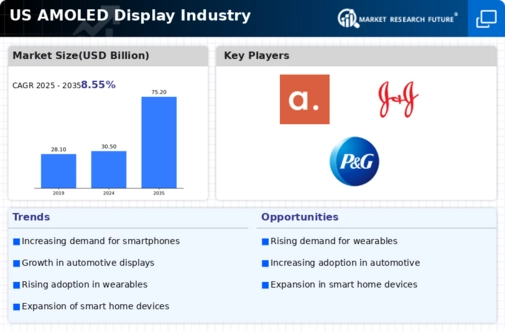Enhanced Energy Efficiency
Energy efficiency is becoming increasingly crucial in the US, particularly as consumers and manufacturers alike seek to reduce their carbon footprints. AMOLED displays are known for their superior energy efficiency compared to traditional LCDs, as they consume less power when displaying darker images. This characteristic is particularly appealing in the context of mobile devices, where battery life is a significant concern. The amoled display market is likely to see growth as more manufacturers highlight the energy-saving benefits of amoled technology. In fact, studies indicate that amoled displays can reduce energy consumption by up to 30% in certain applications. As sustainability becomes a priority for consumers, the demand for energy-efficient displays is expected to rise, further propelling the amoled display market.
Increasing Investment in R&D
Investment in research and development (R&D) within the amoled display market is a critical driver of innovation and growth. Companies are allocating substantial resources to enhance display technologies, focusing on improving resolution, color accuracy, and manufacturing processes. In 2025, it is projected that R&D spending in the display sector will exceed $5 billion in the US alone. This influx of investment is likely to lead to breakthroughs that could lower production costs and improve the performance of amoled displays. As manufacturers strive to differentiate their products in a competitive landscape, advancements in R&D will play a vital role in shaping the future of the amoled display market, potentially leading to new applications and increased market share.
Growing Adoption of Smart Devices
The increasing penetration of smart devices in the US market is a pivotal driver for the amoled display market. As consumers gravitate towards smartphones, tablets, and wearables that utilize amoled technology, the demand for high-quality displays is surging. In 2025, it is estimated that over 70% of smartphones will feature amoled displays, reflecting a significant shift in consumer preferences. This trend is further fueled by the desire for enhanced visual experiences, including vibrant colors and deeper blacks, which amoled technology provides. The amoled display market is thus positioned to benefit from this growing adoption, as manufacturers strive to meet the rising expectations of tech-savvy consumers. Furthermore, the integration of amoled displays in emerging technologies, such as augmented reality and virtual reality devices, is likely to expand the market's reach even further.
Expansion of Automotive Applications
The automotive sector is increasingly adopting advanced display technologies, including amoled displays, to enhance user experience and vehicle aesthetics. As vehicles become more technologically advanced, the integration of high-quality displays for infotainment systems and dashboards is becoming standard. The amoled display market is likely to see substantial growth as automakers recognize the benefits of amoled technology, such as improved visibility and reduced glare. In 2025, it is projected that the automotive display market will reach $10 billion, with a significant portion attributed to amoled displays. This expansion into automotive applications not only diversifies the market but also positions amoled technology as a key player in the future of automotive design and functionality.
Rising Demand for High-Resolution Displays
The demand for high-resolution displays is escalating in the US, driven by consumer preferences for superior visual quality in entertainment and gaming. The amoled display market is poised to benefit from this trend, as amoled technology is renowned for its ability to deliver stunning visuals with high contrast ratios and vibrant colors. In 2025, it is anticipated that the market for 4K and 8K displays will grow significantly, with amoled technology being a preferred choice for premium devices. This shift towards high-resolution displays is likely to attract both consumers and manufacturers, as the desire for immersive experiences continues to rise. Consequently, the amoled display market is expected to expand as it aligns with the growing demand for cutting-edge display technologies.













Leave a Comment